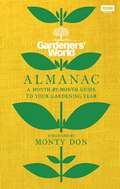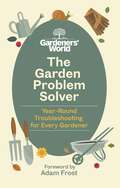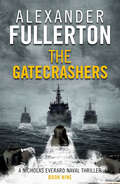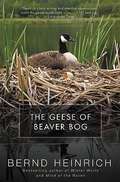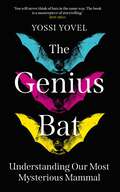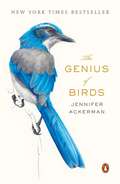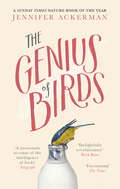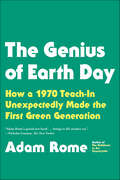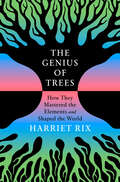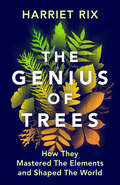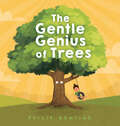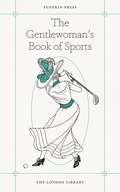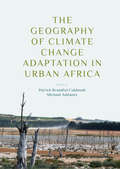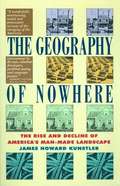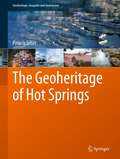- Table View
- List View
The Gardeners’ World Almanac: A month-by-month guide to your gardening year
by Gardeners' World MagazineThe team at Gardeners' World bring you the ultimate guide to your gardening year, from planning and planting to troubleshooting tips and gardening discovery. Organised by month, this book includes lists, timetables, step-by-step guidance and expert advice for year-round gardening, as well as an informative guide on what to plant when and projects for every season. Complemented by beautiful hand-drawn illustrations and tips from your favourite gardening personalities, The Gardeners' World Almanac will help you make your garden look its very best throughout the year.
The Gardeners’ World Problem Solver: Year-Round Troubleshooting for Every Gardener
by Adam Frost BBC Gardeners’ World MagazineEven with the best planning and care, every garden can run into a problem or two. Whether you are beset with beetles or blighted by blackspot, The Garden Problem Solver has the solution.Guided by the team of experts at Gardeners' World - including advice from Monty Don, Alan Titchmarsh, Carol Klein, Arit Anderson, Adam Frost and more - The Garden Problem Solver contains the practical tips, tricks and techniques to deal with the obstacles that every home gardener has to face.Broken down into easy-to-follow steps, this handy guide will help you anticipate, avoid and troubleshoot the most common garden problems which crop up when growing your favourite fruit, veg, flowers and more.With a foreword by Adam Frost and complemented with hand-drawn illustrations, The Garden Problem Solver holds the secrets to making your garden look its very best.
The Gardening in Miniature Prop Shop: Handmade Accessories for Your Tiny Living World
by Janit CalvoA not-so-mini trend The Gardening in Miniature Prop Shop is the next big thing for the crafters and gardeners already captivated by gardening small. Organized by playful themes—including gardens around the world, holidays, and fantasy gardens—it’s a fun-filled guide to creating one-of-a-kind gardens and the accessories that make them shine. Thirty-seven projects are included with fully illustrated, step-by-step instructions. For a Japanese garden, you will learn how to create a miniature sand garden. For a Halloween garden, you'll learn how to make a flying ghost and zombie. And for a space garden, you'll learn how to make a tiny space ship and alien. The Gardening in Miniature Prop Shop is for anyone enchanted by the whimsy of creating a tiny world.
The Gate to Golf
by J Douglas EdgarJames Douglas Edgar (1884-1921) was an English professional golfer and golf writer. He won the French Open in 1914. The Gate to Golf was based on his discoveries made in England. Edgar had an ailing hip which he could not turn freely. Through a series of experiments, he found that a restricted hip turn still allowed a repeatable swing with excellent power and control. This book proved to have significant impact on golf instruction, right up to the present time. Illustrated with photos displaying the technique described in the text.—Print ed.
The Gatecrashers (Nicholas Everard Naval Thrillers)
by Alexander FullertonThe extraordinary, breathless final volume in the Nicholas Everard Naval Thrillers.Six submarines are about to be towed underwater from Scotland to Norway. Their targets: the giant German warships Tirpitz, Scharnhorst and Lutzow.The odds seem stacked against the smaller craft. But if they can survive the nightmarish 2,000-mile tow, Commander Paul Everard will have a chance to gatecrash the fjords and cripple the ship Churchill calls ‘the Beast’.Whether or not he succeeds, the chances of getting out alive are slim. If he fails, his father Nick Everard, escort commander for Arctic convoy PQ19, is in trouble: none of his ships can stand up to Tirpitz’s broadsides. As The Gatecrashers draws to its thunderous climax, father and son face their final and most searching test…Based on the thrilling true story of Operation Source, The Gatecrashers is the blistering culmination of the bestselling Nicholas Everard Naval Thrillers, perfect for fans of Max Hennessy and Alan Evans.Praise for The Nicholas Everard Naval Thrillers‘The prose has a real sense of urgency, and so has the theme. The tension rarely slackens.’ Times Literary Supplement‘The research is unimpeachable and the scent of battle quite overpowering.’ The Sunday Times‘The accuracy and flair of Forester at his best… carefully crafted, exciting and full of patiently assembled technical detail that never intrudes on a good narrative line’ Irish Times
The Gatecrashers: The Nicholas Everard World War Ii Saga Book 6 (Nicholas Everard Naval Thrillers #6)
by Alexander FullertonThe extraordinary, breathless final volume in the Nicholas Everard Naval Thrillers.Six submarines are about to be towed underwater from Scotland to Norway. Their targets: the giant German warships Tirpitz, Scharnhorst and Lutzow.The odds seem stacked against the smaller craft. But if they can survive the nightmarish 2,000-mile tow, Commander Paul Everard will have a chance to gatecrash the fjords and cripple the ship Churchill calls ‘the Beast’.Whether or not he succeeds, the chances of getting out alive are slim. If he fails, his father Nick Everard, escort commander for Arctic convoy PQ19, is in trouble: none of his ships can stand up to Tirpitz’s broadsides. As The Gatecrashers draws to its thunderous climax, father and son face their final and most searching test…Based on the thrilling true story of Operation Source, The Gatecrashers is the blistering culmination of the bestselling Nicholas Everard Naval Thrillers, perfect for fans of Max Hennessy and Alan Evans.Praise for The Nicholas Everard Naval Thrillers‘The prose has a real sense of urgency, and so has the theme. The tension rarely slackens.’ Times Literary Supplement‘The research is unimpeachable and the scent of battle quite overpowering.’ The Sunday Times‘The accuracy and flair of Forester at his best… carefully crafted, exciting and full of patiently assembled technical detail that never intrudes on a good narrative line’ Irish Times
The Geese of Beaver Bog
by Bernd HeinrichWhen award-winning writer and biologist Bernd Heinrich became the unwitting -- but doting -- foster parent of an adorable gosling named Peep, he was drawn into her world. And so, with a scientist's training and a nature lover's boundless enthusiasm, he set out to understand the travails and triumphs of the Canada geese living in the beaver bog adjacent to his home. In The Geese of Beaver Bog, Heinrich takes his readers through mud, icy waters, and overgrown sedge hummocks to unravel the mysteries behind heated battles, suspicious nest raids, jealous outbursts, and more. With deft insight and infectious good humor, he sheds light on how geese live and why they behave as they do. Far from staid or predictable, the lives of geese are packed with adventure and full of surprises. Illustrated throughout with Heinrich's trademark sketches and featuring beautiful four-color photographs, The Geese of Beaver Bog is part love story, part science experiment, and wholly delightful.
The Generosity of Plants: Shared Wisdom from the Community of Herb Lovers
by Rosemary GladstarRenowned herbalist Rosemary Gladstar presents a beautiful keepsake collection of teachings, reflections, and insights on the plant world and herbal healing, featuring diverse voices from the community of herbal teachers and practitioners. A beloved teacher and leader in the herbal healing world for more than 50 years, Rosemary Gladstar has curated this collection to explore key themes in herbalism, including: *The sacred teachings of the plants *The importance of preserving knowledge of the plants' healing properties and the work of herbal healers *The practices of gardening and gathering herbs in the wild *The power and passion of the herbal community *The rich value of living with gratitude and reverence for the Earth, and a deep connection to the plant world. Many of the quotes are original to this collection, excerpted from Gladstar's private correspondence and conversations. Her narrative voice introduces each theme, and the text is accompanied by stunning photographs and artwork celebrating the beauty and wonder of plants.
The Genius Bat: Understanding Our Most Mysterious Mammal
by Yossi YovelStep into the shadows and listen 'Brings the poster-species of Halloween out of the shadows, so we can better appreciate the flying mammal.' National Geographic Usually, you&’ll hear a bat before you see it – the gentle flutter of wings, their high-pitched chatter as they dive and roll for insects. Only occasionally do you spot them, a blur against the evening sky. With nearly 1,500 known species, bats are among the most successful mammals on earth. From the tiny bumblebee bat – which could rest comfortably on your index finger – to the giant golden-crowned flying fox with its 1.5-metre wingspan, they are evolutionary marvels, adapted to practically every environment. The only mammal that can fly, they can reach speeds of up to 100 mph, leaving cheetahs in the dust. Yossi Yovel, an ecologist and neurobiologist, is passionate about deciphering their secrets. In The Genius Bat, he brings to life these amazing creatures as well as the obsessive and sometimes eccentric people who study them. From muddy rainforests to star-covered deserts, from guest houses in Thailand to museum drawers full of fossils in New York, this is an eye-opening account of a remarkable animal. 'A marvellous book.' Nancy Simmons, Curator of Mammalogy, American Museum of Natural History 'Fascinating... Yovel clearly explains bats' vital contributions to a healthier planet.' Merlin Tuttle, author of The Secret Lives of Bats and founder of Bat Conservation International
The Genius of Birds
by Jennifer Ackerman<P>Birds are astonishingly intelligent creatures. In fact, according to revolutionary new research, some birds rival primates and even humans in their remarkable forms of intelligence. Like humans, many birds have enormous brains relative to their size. Although small, bird brains are packed with neurons that allow them to punch well above their weight. <P> In The Genius of Birds, acclaimed author Jennifer Ackerman explores the newly discovered brilliance of birds and how it came about. As she travels around the world to the most cutting-edge frontiers of research-- the distant laboratories of Barbados and New Caledonia, the great tit communities of the United Kingdom and the bowerbird habitats of Australia, the ravaged mid-Atlantic coast after Hurricane Sandy and the warming mountains of central Virginia and the western states--Ackerman not only tells the story of the recently uncovered genius of birds but also delves deeply into the latest findings about the bird brain itself that are revolutionizing our view of what it means to be intelligent. <P>Consider, as Ackerman does, the Clark's nutcracker, a bird that can hide as many as 30,000 seeds over dozens of square miles and remember where it put them several months later; the mockingbirds and thrashers, species that can store 200 to 2,000 different songs in a brain a thousand times smaller than ours; the well-known pigeon, which knows where it's going, even thousands of miles from familiar territory; and the New Caledonian crow, an impressive bird that makes its own tools. <P>But beyond highlighting how birds use their unique genius in technical ways, Ackerman points out the impressive social smarts of birds. They deceive and manipulate. They eavesdrop. They display a strong sense of fairness. They give gifts. They play keep-away and tug-of-war. They tease. They share. They cultivate social networks. They vie for status. They kiss to console one another. They teach their young. They blackmail their parents. They alert one another to danger. They summon witnesses to the death of a peer. They may even grieve. <P>This elegant scientific investigation and travelogue weaves personal anecdotes with fascinating science. Ackerman delivers an extraordinary story that will both give readers a new appreciation for the exceptional talents of birds and let them discover what birds can reveal about our changing world. Incredibly informative and beautifully written, The Genius of Birds richly celebrates the triumphs of these surprising and fiercely intelligent creatures. <P><b>A New York Times Bestseller</b>
The Genius of Birds
by Jennifer AckermanBirds are astonishingly intelligent creatures. In fact, according to revolutionary new research, some birds rival primates and even humans in their remarkable forms of intelligence. Like humans, many birds have enormous brains relative to their size. Although small, bird brains are packed with neurons that allow them to punch well above their weight.In The Genius of Birds, acclaimed author Jennifer Ackerman explores the newly discovered brilliance of birds and how it came about. As she travels around the world to the most cutting-edge frontiers of research - the distant laboratories of Barbados and New Caledonia, the great tit communities of the United Kingdom and the bowerbird habitats of Australia, the ravaged mid-Atlantic coast after Hurricane Sandy and the warming mountains of central Virginia and the western states - Ackerman not only tells the story of the recently uncovered genius of birds but also delves deeply into the latest findings about the bird brain itself that are revolutionizing our view of what it means to be intelligent.Consider, as Ackerman does, the Clark's nutcracker, a bird that can hide as many as 30,000 seeds over dozens of square miles and remember where it put them several months later; the mockingbirds and thrashers, species that can store 200 to 2,000 different songs in a brain a thousand times smaller than ours; the well-known pigeon, which knows where it's going, even thousands of miles from familiar territory; and the New Caledonian crow, an impressive bird that makes its own tools.But beyond highlighting how birds use their unique genius in technical ways, Ackerman points out the impressive social smarts of birds. They deceive and manipulate. They eavesdrop. They display a strong sense of fairness. They give gifts. They play keep-away and tug-of-war. They tease. They share. They cultivate social networks. They vie for status. They kiss to console one another. They teach their young. They blackmail their parents. They alert one another to danger. They summon witnesses to the death of a peer. They may even grieve.This elegant scientific investigation and travelogue weaves personal anecdotes with fascinating science. Ackerman delivers an extraordinary story that will both give readers a new appreciation for the exceptional talents of birds and let them discover what birds can reveal about our changing world.
The Genius of Earth Day: How a 1970 Teach-In Unexpectedly Made the First Green Generation
by Adam RomeThe first Earth Day is the most famous little-known event in modern American history. Because we still pay ritual homage to the planet every April 22, everyone knows something about Earth Day. Some people may also know that Earth Day 1970 made the environmental movement a major force in American political life. But no one has told the whole story before. The story of the first Earth Day is inspiring: it had a power, a freshness, and a seriousness of purpose that are difficult to imagine today. Earth Day 1970 created an entire green generation. Thousands of Earth Day organizers and participants decided to devote their lives to the environmental cause. Earth Day 1970 helped to build a lasting eco-infrastructure—lobbying organizations, environmental beats at newspapers, environmental-studies programs, ecology sections in bookstores, community ecology centers. In The Genius of Earth Day, the prizewinning historian Adam Rome offers a compelling account of the rise of the environmental movement. Drawing on his experience as a journalist as well as his expertise as a scholar, he explains why the first Earth Day was so powerful, bringing one of the greatest political events of the twentieth century to life.
The Genius of Trees: How They Mastered the Elements and Shaped the World
by Harriet RixA mind-expanding exploration of how trees learned to shape our world by manipulating the elements, plants, animals, and even humankind, possessing agency beyond anything we might have imagined&“Astounding . . . a true masterpiece . . . Rix refuses to put herself much in the picture, but through the scenes we glimpse an Indiana Jones figure who is both an eminent, travelling scientist and a born writer.&”—The TelegraphFor a supposedly stationary life-form, trees have demonstrated an astonishing mastery over the environment around them. In The Genius of Trees, tree scientist Harriet Rix reveals the inventive ways trees sculpt their environment and explains the science of how they achieve these incredible feats. Taking us on an awe-inspiring journey through deep history and unseen biochemistry across the globe, Rix restores trees to their rightful station, not as victims of our negligence but as ingenious, stunningly inventive agents in a grand ecological narrative. Trees manipulate fundamental elements, plants, animals, bacteria, fungi, and even humankind to achieve their ends, as seen with oaks in Devon, England, shaping ecosystems through root networks and fungi, and in Amedi, Iraq, changing sexes as they age; laurel rainforests in the Canary Islands regulating water cycles; and metasequoias in California influencing microclimates.Some tree species have gone to extraordinary lengths to make sure their fruits reach large primates, who can spread their seeds over vast distances, while poisoning smaller and less useful mammals. Others can split solid rock and create fertile ground in barren landscapes, effectively building entire ecosystems from scratch. And new discoveries are constantly coming to light: research has shown that trees have an even greater role in preventing global warming than we thought--trees, at one time thought to produce methane actually consume it. We share one world with trees and one need for survival.This eye-opening journey into the inner lives of nature&’s most powerful plant is a profoundly new and original way of understanding both the miracles trees perform and the glories of our natural world.
The Genius of Trees: How They Mastered the Elements and Shaped the World
by Harriet RixThe mesmerizing, mind-expanding global story of how trees have learned to use the soil, air, water, plants, fungi, fire, animals and people around them to shape our world—possessing an agency beyond anything we might have imagined.Taking us on an awe-inspiring journey through deep history and across the globe, The Genius of Trees restores trees to their rightful position not as victims of our negligence but as ingenious, stunningly inventive agents in a grand ecological narrative. Some have been using fire as a reproductive tool since prehistoric times. Others have gone to extraordinary lengths to make sure their fruits reach large primates, who can spread their seeds over vast distances, while poisoning smaller and less useful mammals. Some can split solid rock and create fertile ground in barren landscapes, effectively building entire ecosystems from scratch. For the first time, we witness the inventive and astonishing ways trees sculpt and even master their environment and understand the science of how they achieve these feats. From oaks growing in Devon, England, and Amedi in Iraq to the laurel rainforests of the Canary Islands, metasequoias in California to fossil forests preserved from hundreds of millions of years ago, we see how trees not only farm the landscape in which they grow but also manipulate the elements, other species and even humans to achieve their ends. At once transporting and expert, this eye-opening, mind-expanding journey into the inner lives of nature&’s most powerful plant is a profoundly new and original way of understanding both the miracles trees perform and the glories of our natural world.
The Gentle Genius of Trees
by Philip BuntingLet trees teach you everything from how to branch out to how to stay rooted in this delightful blend of nonfiction and inspirational humor by author-illustrator Philip Bunting!What could we clever humans ever learn from trees? Find out when you take a stroll through the woods and learn a few life lessons from our foliaged friends in this truly special book filled with graphic illustrations. With humor and heart, readers will encounter a small forest of facts. They'll explore the brilliance of trees in creating one interconnected wood-wide web that enables their community to collaborate with each other, share resources, warn of threats, and survive and thrive together.
The Gentlewoman's Book of Sports
by Lady Colin Campbell Lady Greville Lady Milner Miss A.D. Mackenzie Miss C. BowlyIt was not easy to be a sportswoman at the end of the nineteenth century. Pierre de Coubertin, founder of the modern Olympic Games, said in 1896: "No matter how toughened a sportswoman may be, her organism is not cut out to sustain certain shocks." Women competed in the Olympics for the first time in 1900.The "white sailor hats" and the "confu- sion between you, your hat, and the ball" in Lady Greville's book may now seem charmingly old-fashioned--until we remember that in 2015, more than a century later, more than 40% of elite sportswomen in Britain were reported to have suffered sexism. Which suddenly makes the bold gentlewomen of 1892 seem far more pioneering...The books in "Found on the Shelves" have been chosen to give a fascinating insight into the treasures that can be found while browsing in The London Library. Now celebrating its 175th anniversary, with over seventeen miles of shelving and more than a million books, The London Library has become an unrivalled archive of the modes, manners and thoughts of each generation which has helped to form it.From essays on dieting in the 1860s to instructions for gentlewomen on trout-fishing, from advice on the ill health caused by the "modern" craze of bicycling to travelogues from Norway, they are as readable and relevant today as they were more than a century ago - even if contemporary sportswomen no longer have to "thank Providence and one's tailor for one's knickerbockers"!From the Trade Paperback edition.
The Geography of Climate Change Adaptation in Urban Africa
by Patrick Brandful Cobbinah Michael AddaneyThis book take a comprehensive look at several cases of climate change adaptation responses across various sectors and geographical areas in urban Africa and places them within a solid theoretical context. Each chapter is a state-of-the-art overview of a significant topic on climate change adaptation in urban Africa and is written by a leading expert in the field. In addition to the focus on the geography of urban adaptation to climate change in Africa, this collection offers a broader perspective by blending the use of case studies and theory based research. It examines transformations in climate change adaptation and its future orientation from the perspectives of urban planners, political economists, environmentalists, ecologists, economists and geographers, thereby addressing the challenges facing African cities adaptation responses from all angles. Providing up-to-date and authoritative contributions covering the key aspects of climate change adaptation in urban Africa, this book will be of great interest to policymakers, practitioners, scholars and students of geography, urban development and management, environmental science and policy, disaster management, as well as those in the field of urban planning.
The Geography of Climate Change Adaptation in Urban Africa
by Patrick Brandful Cobbinah Michael AddaneyThis book takes a comprehensive look at several cases of climate change adaptation responses across various sectors and geographical areas in urban Africa and places them within a solid theoretical context. Each chapter is a state-of-the-art overview of a significant topic on climate change adaptation in urban Africa and is written by a leading expert in the field. In addition to the focus on the geography of urban adaptation to climate change in Africa, this collection offers a broader perspective by blending the use of case studies and theory based research. It examines transformations in climate change adaptation and its future orientation from the perspectives of urban planners, political economists, environmentalists, ecologists, economists and geographers, thereby addressing the challenges facing African cities adaptation responses from all angles. Providing up-to-date and authoritative contributions covering the key aspects of climate change adaptation in urban Africa, this book will be of great interest to policymakers, practitioners, scholars and students of geography, urban development and management, environmental science and policy, disaster management, as well as those in the field of urban planning.
The Geography of Environmental Crime
by Matthew Hall Gary R. R. Potter Angus NurseThis book critically examines both theory and practice around conservation crimes. It engages with the full complexity of environmental crimes and different responses to them, including: poaching, conservation as a response to wildlife crime, forest degradation, environmental activism, and the application of scientific and situational crime prevention techniques as preventative tools to deal with green crime. Through the contributions of experts from both the social and ecological sciences, the book deals with theoretical and practical considerations that impact on the effectiveness of contemporary environmental criminal justice. It discusses the social construction of green crimes and the varied ways in which poaching and other conservation crimes are perceived, operate and are ideologically driven, as well as practical issues in environmental criminal justice. With contributions based in varied ideological perspectives and drawn from a range of academic disciplines, this volume provides a platform for scholars to debate new ideas about environmental law enforcement, policy, and crime prevention, detection and punishment.
The Geography of Nowhere: The Rise and Decline of America's Man-Made Landscape
by James Howard KunstlerThis book traces the development of modern American car culture and the architecture and social life of cities and suburbs that developed around it.
The Geography of Risk: Epic Storms, Rising Seas, and the Cost of America's Coasts
by Gilbert M. GaulThis century has seen the costliest hurricanes in U.S. history—but who bears the brunt of these monster storms?Consider this: Five of the most expensive hurricanes in history have made landfall since 2005: Katrina ($160 billion), Ike ($40 billion), Sandy ($72 billion), Harvey ($125 billion), and Maria ($90 billion). With more property than ever in harm’s way, and the planet and oceans warming dangerously, it won’t be long before we see a $250 billion hurricane. Why? Because Americans have built $3 trillion worth of property in some of the riskiest places on earth: barrier islands and coastal floodplains. And they have been encouraged to do so by what Gilbert M. Gaul reveals in The Geography of Risk to be a confounding array of federal subsidies, tax breaks, low-interest loans, grants, and government flood insurance that shift the risk of life at the beach from private investors to public taxpayers, radically distorting common notions of risk.These federal incentives, Gaul argues, have resulted in one of the worst planning failures in American history, and the costs to taxpayers are reaching unsustainable levels. We have become responsible for a shocking array of coastal amenities: new roads, bridges, buildings, streetlights, tennis courts, marinas, gazebos, and even spoiled food after hurricanes. TheGeography of Risk will forever change the way you think about the coasts, from the clash between economic interests and nature, to the heated politics of regulators and developers.
The Geography of Spain: A Complete Synthesis (World Regional Geography Book Series)
by Francisco J. TapiadorThis book is the latest and most comprehensive reference to the regional geography of Spain, taking into account emergent issues such as biodiversity, climate change and nationalism. It appeals to scientists as well as to students and instructors and all fields of geography, regional, environmental and cultural studies, and business related disciplines. It covers the whole range of topics from the physical to the human geography of Spain and provides detailed insights into all 17 autonomous communities. Dozens of GIS maps and hundreds of photographs and images including remote sensing imagery make this volume a must have for every geography department.
The Geography of Uzbekistan: At the Crossroads of the Silk Road (World Regional Geography Book Series)
by Lola GulyamovaThis book describes the geography of Uzbekistan and its unique history and culture. It focuses on the development of Uzbekistan as a result of its location on the crossroads of the Silk Road. The influence of global and regional environmental challenges on the current landscape and similar issues are discussed and analyzed from a historical perspective. Contemporary tensions and reforms in social, economical and cultural life are described with the aim to draw a picture of modern paths to transformation and development. The Geography of Uzbekistan includes also information on geology, nature and natural resources, in particular water. The book discusses the social and environmental impacts of the Aral Sea disaster and shows new paths of transformation and development for this Central Asian country.
The Geography of Wine
by Percy H. DoughertyWine has been described as a window into places, cultures and times. Geographers have studied wine since the time of the early Greeks and Romans, when viticulturalists realized that the same grape grown in different geographic regions produced wine with differing olfactory and taste characteristics. This book, based on research presented to the Wine Specialty Group of the Association of American Geographers, shows just how far the relationship has come since the time of Bacchus and Dionysus. Geographers have technical input into the wine industry, with exciting new research tackling subjects such as the impact of climate change on grape production, to the use of remote sensing and Geographical Information Systems for improving the quality of crops. This book explores the interdisciplinary connections and science behind world viticulture. Chapters cover a wide range of topics from the way in which landforms and soil affect wine production, to the climatic aberration of the Niagara wine industry, to the social and structural challenges in reshaping the South African wine industry after the fall of apartheid. The fundamentals are detailed too, with a comparative analysis of Bordeaux and Burgundy, and chapters on the geography of wine and the meaning of the term 'terroir'.
The Geoheritage of Hot Springs (Geoheritage, Geoparks and Geotourism)
by Patricia ErfurtThe aim of this book is to provide an overview of topics related to the extensive geoheritage of hot springs, their natural environments, and their integration into commercial and industrial functions. The eleven chapters explore aspects of historical and cultural traditions, geology and geochemistry, research updates, conservation issues and of course health, wellness, and recreation throughout time. Because natural hot springs and active hydrothermal areas play a significant role in the tourism industry, visitor expectations are examined together with an assessment of common hazards and potential risks in active hydrothermal environments, along with recommendations how to stay safe.For the purpose of showcasing certain unique features, to share noteworthy events and developments or to identify concerns associated with the sustainability of natural water source, examples of particular hot spring areas are included in several chapters. One chapter is also dedicated entirely to the protection of natural hot springs and raises awareness for conservation, while another chapter reviews the history of hot springs in great detail to establish a realistic and justifiable timeline of their original use. Lastly, the significance of natural hot springs for various tourism sectors is analysed and the potential for sustainable future destination development in rural and remote regions is discussed.Many locations were considered and invite the reader to use the information as a reference point in the quest to further explore the remarkable natural and cultural geoheritage of hot springs worldwide.
